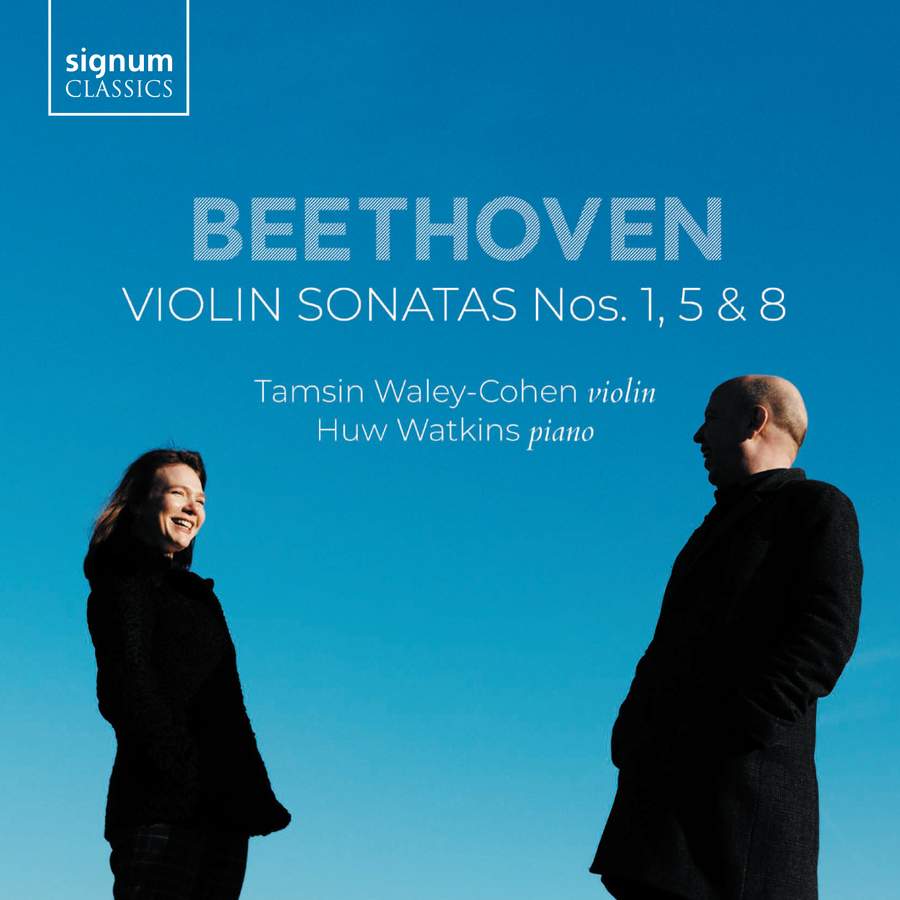BEETHOVEN Violin Sonatas Nos 1, 5 & 8 (Tamsin Waley-Cohen)
View record and artist detailsRecord and Artist Details
Genre:
Chamber
Label: Signum Classics
Magazine Review Date: 08/2020
Media Format: CD or Download
Media Runtime: 63
Mastering:
DDD
Catalogue Number: SIGCD618

Tracks:
| Composition | Artist Credit |
|---|---|
| Sonata for Violin and Piano No. 1 |
Ludwig van Beethoven, Composer
Huw Watkins, Piano Tamsin Waley-Cohen, Violin |
| Sonata for Violin and Piano No. 5, 'Spring' |
Ludwig van Beethoven, Composer
Huw Watkins, Piano Tamsin Waley-Cohen, Violin |
| Sonata for Violin and Piano No. 8 |
Ludwig van Beethoven, Composer
Huw Watkins, Piano Tamsin Waley-Cohen, Violin |
Author: Peter Quantrill
These are closely miked studio accounts, with little sense of the 300-seat Snape Maltings acoustic in which they were recorded, but all the same imbued with the feeling of being caught on the wing. If a note or two of Beethoven’s semiquaver flurries are swallowed up every now and again – in the opening sorties of Op 30 No 3, for instance – that’s the price to be paid for performances which take authentically Beethovenian risks and leave nothing in the rehearsal studio. I’m thinking here, later in the same movement, of the nicely judged pauses to introduce and break up the second subject and Tamsin Waley-Cohen’s pure-toned swells like guileless question marks immediately thereafter.
Such bold strokes of invention may pall on repetition for listeners wedded to the cloudless legato sunshine of Perlman/Ashkenazy or more recently attracted by the lively but cultivated partnership of James Ehnes and Andrew Armstrong (Onyx, 6/20) in this music. On their own terms, however, Waley-Cohen and Watkins demonstrate a fine and modern appreciation for Beethoven the instrumental dramatist, anticipating Weber in the graceful cantilena of the central Minuet and Mendelssohn in the puckish humour of the finale. I enjoyed the flourish of the violinist’s grand entrance in the First Sonata – like a ballgowned diva at the top of a staircase, cameras popping – as well as the more discreet elegance of her pianistic consort as he matches her step for step. The contrast between bow and keys is similarly marked in their address of the slow movement. In the quick finale, however, it’s the violinist who plays second fiddle and tailors her articulation to the nimble fingers of her pianist.
Their complementary personalities (recorded with a balance in the violinist’s favour, unlike Ehnes and Armstrong) meet most harmoniously in the Spring Sonata’s Adagio, where Watkins draws an appealing, fortepiano-like resonance from the piano and Waley-Cohen’s phrasing taps the music’s pastoral roots. While the vestigial Scherzo passes without incident, the finale springs a surprise, taken rather less Allegro and more ma non troppo than most modern rivals. Waley-Cohen makes play here with the full palette of her tone-colours within a classically restrained canvas for the sonata as a whole – there’s no romantically drawn-out pause for thought or mad dash for the double-bar. Each of the three sonatas inhabits its own costume, made to measure.
Discover the world's largest classical music catalogue with Presto Music.

Gramophone Digital Club
- Digital Edition
- Digital Archive
- Reviews Database
- Full website access
From £8.75 / month
Subscribe
Gramophone Full Club
- Print Edition
- Digital Edition
- Digital Archive
- Reviews Database
- Full website access
From £11.00 / month
Subscribe
If you are a library, university or other organisation that would be interested in an institutional subscription to Gramophone please click here for further information.




